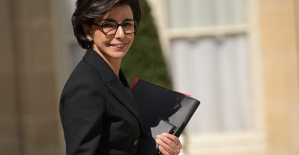It is easy to see why the United States should not join a Russia-Ukraine conflict. The United States does not have a treaty obligation to Ukraine. A war with Russia would be a huge gamble given Russia's potential to expand in Europe, destabilize the region and escalate to the terrifying point of a nuclear exchange.
There are also risks associated with doing too little. This could be interpreted as an acceptance of Russian actions against other countries in Eastern Europe such as Estonia, Latvia, and Lithuania. However, as NATO members, these three states have security assurances from the United States.
Antony Blinken is visiting Europe this week to meet with officials in Ukraine, consult NATO allies, and then meet with his Russian counterpart Friday. He has stated "an unshakeable U.S. commitment for Ukraine's sovereignty, territorial integrity," but he has not defined its limits publicly.
What would the United States and its allies do to support Ukraine if they were to invade Ukraine due to the presence of Russian forces at its borders?
WHY NOT CONTEST A RUSSIAN INVASION?
The possibility of a war with Russia in Ukraine could entail years of U.S. resources and forces. It would also be a significant cost in human lives, and leave no guarantees for a positive outcome. This is all at a time when Biden's administration is trying to put its attention on China as the main security threat.
Biden stated Wednesday that he believes Russian President Vladimir Putin will send forces to Ukraine. However, he said that he does not believe Putin wants war. Biden didn't mention the possibility that U.S. troops could be sent to Ukraine to prevent an invasion. However, he had previously ruled this out.
Biden stated that he was unsure how Putin will use the force he assembled close to Ukraine's borders. However, the United States and NATO rejected Moscow's main demand -- a guarantee the West alliance would not expand eastward. After the removal of the Moscow-friendly leader in Ukraine, Russia annexed Crimea from Ukraine in 2014. It also intervened in eastern Ukraine the same year to support separatist insurgents. In the eight-years of fighting, more than 14,000 people were killed.
Both militarily and politically, the stakes are high in Ukraine. Lawmakers have increased their criticism of Biden’s approach to Putin. Oklahoma's Senator James Inhofe, who is the Senate Armed Services Committee's ranking Republican, has accused Biden "handwringing" and "appeasement" but he hasn’t called for the deployment of combat troops. Rep. Jim Himes (a Connecticut Democrat) called for an urgent nonstop airlift of military equipment into Ukraine.
Philip Breedlove is a former Air Force General who was the top NATO commander in Europe between 2013 and 2016. He said that he doesn't expect or recommend the United States sending combat troops to Ukraine. He said that Washington and its allies should instead be seeking ways to assist Ukraine in defending its airspace and territorial waters. This is where Russia has overwhelming superiority.
He said, "These are things we should consider as an alliance or as a country." "If Putin allows Ukraine to be invaded, and there are to be no consequences, we will see even more of the same."
WHAT ARE BIDEN’S OTHER OPTIONS
Ukraine's obvious military weakness would make it impossible for Russian forces to invade. If Putin were to convince himself that the costs are too high, he might be deterred from acting by the United States and other countries.
"The key to thwarting Russian ambitions" is to stop Moscow having a quick win and to increase the economic, political and military costs by imposing sanctions, ensuring political isolation and raising the prospect for a prolonged insurgency which grinds away Russia's military," Seth Jones (a political scientist) and Philip Wasielewski (a former CIA paramilitary officers) wrote in a Jan. 13, analysis for the Center for Strategic and International Studies.
Biden's administration suggested that it was thinking in similar ways.
WHAT IS THE U.S. DOING? SUPPORTING UKRAINE'S MILITARY NOW?
John Kirby, Pentagon press secretary, stated that there are approximately 200 National Guard soldiers in Ukraine who train and advise local forces. He also said on Tuesday that there is no plan to increase their numbers. Unknown numbers of special operations troops from the United States are also training in Ukraine. Kirby would not say whether U.S. troops would withdraw in the event that a Russian invasion occurs, but he stated that the Pentagon would make all appropriate and proper decisions to ensure our citizens are safe in any situation.
Wednesday's announcement by the administration indicated that it will provide another $200 million in defense military assistance to Ukraine. The United States has provided Ukraine defense assistance totaling approximately $2.5 billion since 2014. This includes anti-tank missiles, radars, and radars.
WHAT CAN THE U.S. DO TO HELP UKRAINE INTEREST AFTER A INVASION?
It is not clear. It's not clear.
According to the administration, it is also open to sending military reinforcements for NATO allies on NATO's eastern front who need American assurances.
Jones and Wasielewski believe that the United States should not only impose severe sanctions on Russia in the case of an invasion but also provide Ukraine with a wide range of military assistance at no charge. This would include anti-tank, anti-ship, electronic warfare, cyber defense systems, small arms, artillery ammunition and other items.
They wrote that the United States and NATO should be ready to provide long-term support for Ukraine's resistance, no matter how it turns out. They said that this aid could be provided overtly by U.S. troops including special operations forces or could be a CIA-led, covert operation authorized by President Biden.
This would increase the chance of U.S. personnel being in the line-of-fire, and draw the United States into the exact combat it is determined to avoid.

 Iran-Israel conflict: what we know about the events of the night after the explosions in Isfahan
Iran-Israel conflict: what we know about the events of the night after the explosions in Isfahan Sydney: Assyrian bishop stabbed, conservative TikToker outspoken on Islam
Sydney: Assyrian bishop stabbed, conservative TikToker outspoken on Islam Torrential rains in Dubai: “The event is so intense that we cannot find analogues in our databases”
Torrential rains in Dubai: “The event is so intense that we cannot find analogues in our databases” Rishi Sunak wants a tobacco-free UK
Rishi Sunak wants a tobacco-free UK Alert on the return of whooping cough, a dangerous respiratory infection for babies
Alert on the return of whooping cough, a dangerous respiratory infection for babies Can relaxation, sophrology and meditation help with insomnia?
Can relaxation, sophrology and meditation help with insomnia? WHO concerned about spread of H5N1 avian flu to new species, including humans
WHO concerned about spread of H5N1 avian flu to new species, including humans New generation mosquito nets prove much more effective against malaria
New generation mosquito nets prove much more effective against malaria The A13 motorway closed in both directions for an “indefinite period” between Paris and Normandy
The A13 motorway closed in both directions for an “indefinite period” between Paris and Normandy The commitment to reduce taxes of 2 billion euros for households “will be kept”, assures Gabriel Attal
The commitment to reduce taxes of 2 billion euros for households “will be kept”, assures Gabriel Attal Unemployment insurance: Gabriel Attal leans more towards a tightening of affiliation conditions
Unemployment insurance: Gabriel Attal leans more towards a tightening of affiliation conditions “Shrinkflation”: soon posters on shelves to alert consumers
“Shrinkflation”: soon posters on shelves to alert consumers The restored first part of Abel Gance's Napoléon presented at Cannes Classics
The restored first part of Abel Gance's Napoléon presented at Cannes Classics Sting and Deep Purple once again on the bill at the next Montreux Jazz Festival
Sting and Deep Purple once again on the bill at the next Montreux Jazz Festival Rachida Dati: one hundred days of Culture on the credo of anti-elitism
Rachida Dati: one hundred days of Culture on the credo of anti-elitism The unbearable wait for Marlène Schiappa’s next masterpiece
The unbearable wait for Marlène Schiappa’s next masterpiece Skoda Kodiaq 2024: a 'beast' plug-in hybrid SUV
Skoda Kodiaq 2024: a 'beast' plug-in hybrid SUV Tesla launches a new Model Y with 600 km of autonomy at a "more accessible price"
Tesla launches a new Model Y with 600 km of autonomy at a "more accessible price" The 10 best-selling cars in March 2024 in Spain: sales fall due to Easter
The 10 best-selling cars in March 2024 in Spain: sales fall due to Easter A private jet company buys more than 100 flying cars
A private jet company buys more than 100 flying cars This is how housing prices have changed in Spain in the last decade
This is how housing prices have changed in Spain in the last decade The home mortgage firm drops 10% in January and interest soars to 3.46%
The home mortgage firm drops 10% in January and interest soars to 3.46% The jewel of the Rocío de Nagüeles urbanization: a dream villa in Marbella
The jewel of the Rocío de Nagüeles urbanization: a dream villa in Marbella Rental prices grow by 7.3% in February: where does it go up and where does it go down?
Rental prices grow by 7.3% in February: where does it go up and where does it go down? With the promise of a “real burst of authority”, Gabriel Attal provokes the ire of the opposition
With the promise of a “real burst of authority”, Gabriel Attal provokes the ire of the opposition Europeans: the schedule of debates to follow between now and June 9
Europeans: the schedule of debates to follow between now and June 9 Europeans: “In France, there is a left and there is a right,” assures Bellamy
Europeans: “In France, there is a left and there is a right,” assures Bellamy During the night of the economy, the right points out the budgetary flaws of the macronie
During the night of the economy, the right points out the budgetary flaws of the macronie These French cities that will boycott the World Cup in Qatar
These French cities that will boycott the World Cup in Qatar Champions League: France out of the race for 5th qualifying place
Champions League: France out of the race for 5th qualifying place Ligue 1: at what time and on which channel to watch Nantes-Rennes?
Ligue 1: at what time and on which channel to watch Nantes-Rennes? Marseille-Benfica: 2.99 million viewers watching OM’s victory on M6
Marseille-Benfica: 2.99 million viewers watching OM’s victory on M6 Cycling: Cofidis continues its professional adventure until 2028
Cycling: Cofidis continues its professional adventure until 2028


















